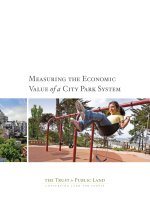The economic survival of americas isolated small towns
Bạn đang xem bản rút gọn của tài liệu. Xem và tải ngay bản đầy đủ của tài liệu tại đây (5.21 MB, 264 trang )
The Economic
Survival of America’s
Isolated Small Towns
PUBLIC ADMINISTRATION AND PUBLIC POLICY
A Comprehensive Publication Program
EDITOR-IN-CHIEF
DAVID H. ROSENBLOOM
Distinguished Professor of Public Administration
American University, Washington, DC
Founding Editor
JACK RABIN
RECENTLY PUBLISHED BOOKS
The Economic Survival of America’s Isolated Small Towns, Gerald L. Gordon
Public Administration and Policy in the Caribbean, Indianna D. Minto-Coy
and Evan Berman
Sustainable Development and Human Security in Africa: Governance as the
Missing Link, Louis A. Picard, Terry F. Buss, Taylor B. Seybolt, and
Macrina C. Lelei
Information and Communication Technologies in Public Administration:
Innovations from Developed Countries, Christopher G. Reddick and
Leonidas Anthopoulos
Creating Public Value in Practice: Advancing the Common Good in a Multi-Sector,
Shared-Power, No-One-Wholly-in-Charge World, edited by John M. Bryson,
Barbara C. Crosby, and Laura Bloomberg
Digital Divides: The New Challenges and Opportunities of e-Inclusion,
Kim Andreasson
Living Legends and Full Agency: Implications of Repealing the Combat
Exclusion Policy, G.L.A. Harris
Politics of Preference: India, United States, and South Africa, Krishna K. Tummala
Crisis and Emergency Management: Theory and Practice, Second Edition,
Ali Farazmand
Labor Relations in the Public Sector, Fifth Edition, Richard C. Kearney and
Patrice M. Mareschal
Democracy and Public Administration in Pakistan, Amna Imam and Eazaz A. Dar
The Economic Viability of Micropolitan America, Gerald L. Gordon
Personnel Management in Government: Politics and Process, Seventh Edition,
Katherine C. Naff, Norma M. Riccucci, and Siegrun Fox Freyss
Public Administration in South Asia: India, Bangladesh, and Pakistan, edited by
Meghna Sabharwal and Evan M. Berman
Available Electronically
PublicADMINISTRATIONnetBASE
/>
The Economic
Survival of America’s
Isolated Small Towns
Gerald L. Gordon
CRC Press
Taylor & Francis Group
6000 Broken Sound Parkway NW, Suite 300
Boca Raton, FL 33487-2742
© 2016 by Taylor & Francis Group, LLC
CRC Press is an imprint of Taylor & Francis Group, an Informa business
No claim to original U.S. Government works
Version Date: 20150521
International Standard Book Number-13: 978-1-4822-4883-8 (eBook - PDF)
This book contains information obtained from authentic and highly regarded sources. Reasonable
efforts have been made to publish reliable data and information, but the author and publisher cannot
assume responsibility for the validity of all materials or the consequences of their use. The authors and
publishers have attempted to trace the copyright holders of all material reproduced in this publication
and apologize to copyright holders if permission to publish in this form has not been obtained. If any
copyright material has not been acknowledged please write and let us know so we may rectify in any
future reprint.
Except as permitted under U.S. Copyright Law, no part of this book may be reprinted, reproduced,
transmitted, or utilized in any form by any electronic, mechanical, or other means, now known or
hereafter invented, including photocopying, microfilming, and recording, or in any information storage or retrieval system, without written permission from the publishers.
For permission to photocopy or use material electronically from this work, please access www.copyright.com ( or contact the Copyright Clearance Center, Inc. (CCC), 222
Rosewood Drive, Danvers, MA 01923, 978-750-8400. CCC is a not-for-profit organization that provides licenses and registration for a variety of users. For organizations that have been granted a photocopy license by the CCC, a separate system of payment has been arranged.
Trademark Notice: Product or corporate names may be trademarks or registered trademarks, and are
used only for identification and explanation without intent to infringe.
Visit the Taylor & Francis Web site at
and the CRC Press Web site at
The dictionary defines community as a group of people
who live in the same area, such as a city, town, or neighborhood,
and who have the same interests (www.merriam-webster.com).
In seventeen of the fifty-one case studies in this research,
the interviewees were asked what lessons they had learned from
which others might benefit. One-third (seventeen) immediately
said that economic growth in a small town is a team sport and that
everyone must be in on the planning and execution of the plans.
This text is dedicated to the elected and appointed officials
of America’s small, isolated cities and towns—and all of their neighbors
who get involved. Indeed, they all have the same interests and
they all take part—because they are part of the community.
Contents
Preface...............................................................................................................xiii
Acknowledgments.............................................................................................. xv
About the Author.............................................................................................xvii
1 Introduction............................................................................................1
Previous Research.........................................................................................1
What Is a Small City or Town, and Who Lives in Them?.............................6
What Does It Mean for a Small Town to Be Isolated,
and Why Is That Important?......................................................................14
Selecting the Case Study Cities...................................................................17
Similarities and Dissimilarities between the Economic Forces
and Solutions Facing Large Cities and Small Towns...................................35
2 Fifty-One of America’s Small and Isolated Cities Examined.................41
Northwest Region...................................................................................... 42
Emmett, Idaho...................................................................................... 42
Interview with the Honorable Bill Buttucci,
Mayor of Emmett, Idaho...................................................................43
Rupert, Idaho.........................................................................................45
Interview with Kelly A. Anthon,
City Administrator of Rupert, Idaho.................................................47
Lewistown, Montana..............................................................................50
Interview with Kevin Myhre,
City Manager of Lewistown, Montana..............................................50
Lincoln, Oregon.....................................................................................53
Interview with David Hawker,
City Manager of Lincoln, Oregon.....................................................54
Ephrata, Washington.............................................................................56
Interview with Wes Crago,
City Administrator of Ephrata, Washington......................................57
Cody, Wyoming.....................................................................................59
Interview with the Honorable Nancy Tia Brown, Mayor,
and Jenni Rosencrance, City Administrator of Cody, Wyoming........60
vii
viii ◾ Contents
Douglas, Wyoming................................................................................62
Interview with Tony Tolstedt,
City Administrator of Douglas, Wyoming........................................63
North Central.............................................................................................65
Algona, Iowa..........................................................................................65
Interview with Keri Navratil, City Administrator of Algona, Iowa...... 66
Detroit Lakes, Minnesota.......................................................................68
Interview with Bob Louiseau, City Manager,
and Larry Remmen, Community Development Director
of Detroit Lakes, Minnesota..............................................................69
International Falls, Minnesota...............................................................72
Interview with the Honorable Bob Anderson,
Mayor of International Falls, Minnesota............................................73
Montevideo, Minnesota.........................................................................76
Interview with Steve Jones,
City Manager of Montevideo, Minnesota......................................... 77
Holdrege, Nebraska................................................................................79
Interview with Robert Rager,
City Administrator of Holdrege, Nebraska........................................80
Sidney, Nebraska....................................................................................82
Interview with Gary Person, City Manager of Sidney, Nebraska.......83
Valley City, North Dakota.....................................................................86
Interview with David Schelkopf,
City Manager of Valley City, North Dakota......................................87
Great Lakes.................................................................................................89
Carmi, Illinois........................................................................................89
Interview with Sandra Irvine,
City Administrator of Carmi, Illinois............................................... 90
Kingsford, Michigan..............................................................................92
Interview with Tony Edelbeck,
City Manager of Kingsford, Michigan..............................................92
Ashland, Wisconsin...............................................................................94
Interview with the Honorable Bill Whalen,
Mayor of Ashland, Wisconsin............................................................95
Rice Lake, Wisconsin.............................................................................97
Interview with Curt Snyder,
City Administrator of Rice Lake, Wisconsin.....................................98
Northeast..................................................................................................100
Caribou, Maine....................................................................................100
Interview with Austin Bleess, City Manager of Caribou, Maine......101
Titusville, Pennsylvania........................................................................104
Interview with Larry Manross,
City Manager of Titusville, Pennsylvania........................................104
Contents ◾ ix
Southeast..................................................................................................106
Arab, Alabama.....................................................................................106
Interview with the Honorable Bob Joslin,
Mayor of Arab, Alabama.................................................................107
Hamilton, Alabama..............................................................................109
Interview with the Honorable Wade Williams,
Mayor of Hamilton, Alabama.......................................................... 110
Thomaston, Georgia.............................................................................112
Interview with the Honorable Hays Arnold, Mayor,
and Patrick Comiskey, City Manager of Thomaston, Georgia.........113
Kosciusko, Mississippi.......................................................................... 116
Interview with the Honorable Jimmy Cockroft,
Mayor of Kosciusko, Mississippi...................................................... 117
Brevard, North Carolina...................................................................... 119
Interview with Joe Moore,
City Manager of Brevard, North Carolina....................................... 119
Roxboro, North Carolina.....................................................................121
Interview with Stephen Steese,
City Manager of Roxboro, North Carolina......................................122
Covington, Tennessee..........................................................................124
Interview with the Honorable David Gordon,
Mayor of Covington, Tennessee......................................................125
Lexington, Tennessee...........................................................................127
Interview with the Honorable David Jowers,
Mayor of Lexington, Tennessee.......................................................128
McKenzie, Tennessee...........................................................................131
Interview with the Honorable Jill Holland,
Mayor of McKenzie, Tennessee.......................................................132
Galax, Virginia.....................................................................................135
Interview with Keith Barker, City Manager of Galax, Virginia........135
South Boston, Virginia.........................................................................138
Interview with the Honorable Ed Owens,
Mayor of South Boston, Virginia.....................................................139
Elkins, West Virginia...........................................................................141
Interview with the Honorable Van Broughton,
Mayor of Elkins, West Virginia.......................................................142
South Central...........................................................................................144
Pocahontas, Arkansas...........................................................................144
Interview with the Honorable Frank Bigger,
Mayor of Pocahontas, Arkansas....................................................... 145
x ◾ Contents
Colby, Kansas.......................................................................................147
Interview with Tyson McGreer, City Manager,
and Christy Preston, Director of Economic Development,
Colby, Kansas..................................................................................148
Fort Scott, Kansas................................................................................ 151
Interview with Dave Martin, City Manager of Fort Scott, Kansas...... 151
Charleston, Missouri............................................................................ 153
Interview with Richard Goode,
City Manager of Charleston, Missouri............................................154
Chillicothe, Missouri........................................................................... 157
Interview with Ike Holland,
City Administrator of Chillicothe, Missouri.................................... 157
Perryville, Missouri.............................................................................. 159
Interview with the Honorable Deborah Gahan, Mayor,
Brent Buerke, City Manager, and Scott Sattler,
Director of Economic Development, Perryville, Missouri...............160
Breckenridge, Texas..............................................................................162
Interview with Andy McCuistion,
City Manager of Breckenridge, Texas..............................................163
Elsa, Texas............................................................................................165
Interview with Joe Contu, City Manager of Elsa, Texas..................166
Pecos, Texas.........................................................................................168
Interview with the Honorable Venetta Seals,
Mayor of Pecos, Texas......................................................................169
West and Southwest..................................................................................171
Winslow, Arizona.................................................................................171
Interview with Stephen Pauken,
City Manager of Winslow, Arizona.................................................171
Fort Bragg, California.......................................................................... 174
Interview with Linda Ruffing,
City Manager of Fort Bragg, California...........................................175
Yreka, California..................................................................................177
Interview with Steve Baker, City Manager of Yreka, California.......178
Delta, Colorado.................................................................................... 181
Interview with Justin Clifton, City Manager of Delta, Colorado..... 181
Gunnison, Colorado............................................................................183
Interview with Ken Coleman,
City Manager of Gunnison, Colorado.............................................184
Lamar, Colorado..................................................................................186
Interview with the Honorable Roger Stagner,
Mayor of Lamar, Colorado..............................................................187
Contents ◾ xi
Salida, Colorado...................................................................................189
Interview with the Honorable Jim Dickson,
Mayor of Salida, Colorado...............................................................189
Winnemucca, Nevada.......................................................................... 191
Interview with Steve West,
City Manager of Winnemucca, Nevada...........................................192
Taos, New Mexico...............................................................................194
Interview with Rick Bellis, City Manager of Taos, New Mexico.....195
Vernal, Utah.........................................................................................198
Interview with Ken Bassett, City Manager of Vernal, Utah.............199
3 Conclusions about Growth in America’s Small and Isolated Cities....203
The Relevance of Lessons Learned in Micropolitan Cities
to Those That Are Small and Isolated........................................................203
Will Technology Enable Small Towns to Survive?................................... 204
Are There Advantages for Employers in Small, Isolated Cities?.................205
Why Should We Care about America’s Cities That Are Small
and Isolated?.............................................................................................205
Special Considerations for Small, Isolated Cities and Towns................... 206
The Brain Drain and Postsecondary Education................................... 206
If You Build It, Will They Really Come?............................................. 208
4 A Special Case Study: Raton, New Mexico..........................................211
What Happens to a City without Jobs?..................................................... 211
Interview with Paula Murphy, Publisher of the Raton Range.....................213
5 Issues for Future Economic Growth, by City and Region...................217
Bibliography.................................................................................................235
Index............................................................................................................239
Preface
The economic history of the recent decade has been volatile at best and devastating
at its worst. It has rather depended upon where one sits. If your community has
either fared well and weathered the storms, or managed to recover, it’s been tolerable.
However, if you live in a city that was devastated once, twice, or three times, or that
lost relatively high numbers of jobs and has not been able to recover, then this period
of time has been damaging for your communities, employers, workers, and families.
If you live in a large city or metropolitan area, although there may have been
significant job fluctuations, you may have weathered those same storms a little
better simply because there is a greater mass of jobs near you. In small towns, the
impacts have tended to be greater. In the small, isolated cities of this great nation,
the impacts have tended to be significantly more severe.
Still, some cities survived while others did not. This research has examined
which is which and why some cities are in good shape while others have not returned
to their earlier highs in population, tax base, or employment opportunities. Did
some do things right? Were some simply better positioned? And finally, are there
some basic lessons that the leaders of these cities and towns learned that can benefit
other leaders in other cities as they confront similar issues and situations?
xiii
Acknowledgments
Many people have contributed to my professional success. They have made it possible for me to succeed in my life and in my career. Others have made it possible to
successfully complete my books. At the risk of repetition, I gratefully acknowledge
the support of Alan Fogg and Vicki Reeve in my office as well as my right arm,
Cheryl Martelli, without whom I simply would not have finished this.
I have the privilege of working for a board comprised of seven men and women
from the business community who support me in all my endeavors, professional
and otherwise. One could not have a better board than Steven Davis, Mike Lewis,
Ronald Johnson, Cathy Lange, Mark Lowham, Bud Morrissette, and Sudhakar
Shenoy, and their predecessors of thirty-one very productive years. A very special
thanks goes to Dr. Johnson, who grew up in a rural area of Virginia and who tutored
me (a city kid) in the ways of rural communities and their economic foundations.
The lessons were invaluable as I conducted my research.
The photo preceding the main text of this book is courtesy of Abby Gentry.
xv
About the Author
Virginia Business Magazine named Dr. Gerald L. Gordon the 2010 Virginia
Business Person of the Year, and Leadership Fairfax, Inc., named Dr. Gordon the
recipient of its 2011 Northern Virginia Regional Leadership Award.
Dr. Gordon is the president and chief executive officer of the Economic
Development Authority in Fairfax County, Virginia, one of the largest office space
markets in the United States. He has been with the FCEDA since late 1983. In that
time, office space in the county has grown from 32 million square feet to nearly
120 million square feet and jobs in the county grew from 243,000 to approximately
600,000. As a result, the real estate tax rate has decreased from $1.47 to $1.07.
In 2005, the FCEDA was named by Site Selection Magazine as one of the
Top Ten Economic Development Organizations in North America and, in 2007,
Time magazine called Fairfax County “one of the great economic success stories
of our time.” In 2011, The Washington Post wrote, “Fairfax County remains the
economic wunderkind of Virginia and in many ways of the Washington area.”
Dr. Gordon previously taught at the Catholic University of America, the
University of Maryland, George Mason University, and Virginia Commonwealth
University. He has consulted with numerous city and state governments throughout the United States as well as the governments of the Republic of Poland, the
island of Vieques in Puerto Rico, and the Federated States of Micronesia. He
has also served as a consultant to various government agencies, the US Navy,
businesses, nonprofit organizations, associations, colleges and universities, and the
United Nations.
Dr. Gordon holds a bachelor’s degree from The Citadel, a master’s degree from
George Washington University, and a doctorate in international economics from
the Catholic University of America. He is also the author of thirteen books and
numerous articles on strategic planning and economic development. His most
recent books are Reinventing Local and Regional Economies (2011) and The Formula
for Economic Growth on Main Street America (2009).
Dr. Gordon is the 2003 recipient of the prestigious Israel Freedom Award
of the Israel Bonds organization. In 2006, he became the first American to
address the All-Parliamentary Exports Group in the British House of Commons.
xvii
xviii ◾ About the Author
In 2007, he was accepted for inclusion on the roster of Fulbright Senior Scholars
and was named a Fellow of the International Economic Development Council.
In 2010, he received the James Rees Award from the Fairfax County Chamber of
Commerce, and in 2012 he was named the TrendLines Trendsetter of the Year for
the Washington, DC, metropolitan area.
Chapter 1
Introduction
Previous Research
I have authored three books in the past four years relating to the growth of local economies, ranging from those of major cities to regional economies to micropolitan-sized
cities, the latter having between ten thousand and fifty thousand residents. These
were The Formula for Economic Growth on Main Street America (New York: CRC
Press, 2009), Reinventing Local and Regional Economies (New York: CRC Press, 2011),
and The Economic Viability of Micropolitan America (New York: CRC Press, 2013).
In each book, differing perspectives on economic development and comebacks
from economic decline were derived. This was accomplished by assigning to each
set of research cities of different sizes. The first of the books looked at general principles of growth and recovery. The subsequent books considered large cities and
major metropolitan regions and micropolitan communities.
In this way, the research was designed to help us understand better what makes
local economies of varying sizes either grow or contract, and why some cities can
recover and thrive while others cannot. Finally, the ultimate exercise was designed
to identify the best lessons from each of those municipal settings in order to extract
the most valuable lessons that could be replicated in other communities of similar
sizes and economic conditions, as well as to clarify which of the lessons learned
are more or less applicable to cities of certain sizes and circumstances and which
are more generally applicable to municipalities generally.
As one might expect, the conclusions in each successive component of the
research indicate that there are some commonalities between cities of different
sizes when it comes to economic growth and economic development, as well as
to the decline that many cities confront over time. Much of these distinctions are
1
2 ◾ The Economic Survival of America's Isolated Small Towns
the result of ever-changing conditions—macro and micro—while other factors can
play a key role as well.
But here’s the tricky part: not all of the impacting factors are within the control
of the cities’ leadership. Global commodity prices, cheaper overseas labor, and the
legislative actions of the states within which they are located can be among the most
important of the many considerations. For that reason, the cities in the research
long ago concluded that, first and foremost, they must address those issues over
which they are able to exercise some degree of control. Otherwise, time, energy,
and precious resources can be squandered on activities that are the least likely to
yield positive returns. This becomes increasingly clear in this study and increasingly
clear to the leaders of these smaller cities and towns because their options—and
their resources—are far fewer than those at the disposal of larger communities, and
especially those of major cities and metropolitan regions.
There are, of course, many differences between cities of the same or similar
sizes as well. That is where the lessons learned have proven most instructive for
other municipal leaders. Another reason for the presumed value for municipalities
and their leaders is that this is not an anthology of lessons gleaned from research
or theories. It is not even a larger reflection of the purposes of a single author. The
research for each of these books has been done primarily through extensive discussions with the leaders of the communities identified for inclusion in this book.
The stories told and the lessons learned—and thus reported—are theirs. They are
taken from direct interviews with those men and women who actually lived and
worked through the city histories involved. It was their collective stories I told,
in the case of one book, seventy mayors and other community leaders, including
collegepresidents, chambers of commerce, executives, and more; and in another
case, seventy mayors of micropolitan cities across America.
The next logical consideration—following large urban regions, primary cities,
and micropolitan cities and towns—is the small towns that dot the US map. As
these small towns attempt to build or rebuild their economic bases, what lessons
have they learned? What are the common elements of those lessons as relates to
what worked and what did not work? And finally, what guidelines may be extracted
that could be instructive to the leadership of other small cities and towns that could
enable them to grow faster or better, or to recover more quickly? To be true to that
objective and the presumption that it would be their conclusions that would be of
greatest benefit to their peers in other communities, each of the fifty-plus interviews
concluded with the same question: “If you were speaking to a room full of other
city managers/mayors from other, similarly sized municipalities that have similar
sets of circumstances, what lessons would you offer them?”
As such, this research is, once again, the result of detailed studies of the histories of these experiences through the eyes and words of those who lived them.
Interviews with city administrators or fifty mayors of small cities and towns with
common challenges and common interests have generated a base of intelligence
from which to conclude what are generally more effective approaches to economic
Introduction ◾ 3
development, economic growth, and economic revitalization in other small towns
across the United States.
Of course, this does not imply that there can be established a formula that, once
applied, can guarantee small cities and towns of future economic success. It simply
implies that when similar approaches have been relatively effective in certain settings, they are worthy of consideration by others in similar sets of circumstances.
As well, that which has been ineffective with some consistency provides a message to
other similar cities that while such a strategy might work for them, there are certain
pitfalls to avoid when trying. There is no “one size fits all” in economic development.
According to a publication of the International City Management Association
(ICMA), there are 3142 nonmetropolitan counties in the United States, of which
roughly two-thirds are rural. These areas, however, contain seventeen percent of the
nation’s total population and represent about seventy-five percent of the total land
area (ICMA, 2012). Further to this point, Huston wrote that eighty-seven percent
of all American cities in the census report of 2000 had fewer than ten thousand
residents (Huston, 2009).
Clearly, rural America is an important part of our national makeup, and its
needs and economic challenges need to be given due consideration by legislatures
at all levels. Once the backbone of the nation, many of these cities and regions
had gained their initial prominence because they were located at or near major
intersections or waterways. The advent of the railroads, and eventually the airports,
diminished the value of some of those locations.
Even infrastructure improvements that would seem to benefit small towns often
had a detrimental side to them. As a positive, the interstate highway system, for
example, meant that the small and isolated areas could be reached more easily.
But it also meant that their residents could reach other areas more easily. Several of
the small town leaders interviewed in this study mentioned that because interstate
highways represent significant pass-through traffic, major national retailers located
nearby. This includes, most notably, Walmart. While new jobs became available
as a result and residents had enhanced shopping available, there were also harmful
effects that resulted.
A national chain like Walmart meant problems for the main street merchants in
small town America, which simply could not compete. The result was lost revenues,
closed shops in small city downtowns, and even decreased revenues for those cities
in which sales taxes are a primary source of general fund resources, and hence the
public services the cities can provide to their residents and visitors. Of course, these
“big-box” stores locate where the tax benefits are best. This means that they often
locate near the interstate highways but just over the lines between the cities and
their neighboring counties.
This leads to the question of where the revenues go. In such cases, small town
residents spend their earnings and, rather than resulting in enhanced public services
for their communities, simply enhance the profits of far-flung corporations.
4 ◾ The Economic Survival of America's Isolated Small Towns
These kinds of considerations have caused many to ask what such communities can reasonably do to generate local retail opportunities. Again, this is of
particular importance if the city in question derives much of its local general fund
from income tax revenues. One study wrote that “not every small town commercial
center can come back; some may be just too far gone” (Benfield, 2012). And more
than one analyst focused specifically on Walmart as one chain that, when it went
nationwide, seriously hurt many main street merchants in small towns, even referring to the corporate giant as “main street killers” and other very negative terms.
These small towns, while highly diverse, demonstrate some patterns to their
main street development as well. Traynham (2009) wrote: “The usual small town
of twenty-five hundred people has two grocery stores, two food stores, a couple of
veterinarians, a ‘good’ restaurant, a beauty shop, a lawyer or three, an insurance
agent, a hardware store, and a pharmacy.” But, decades ago, many of them had
strong agriculture-based economies. So important to many small town economies
was agriculture that one writer quoted an interviewee who said, “Two bad wheat
markets will touch my business quicker than the tightening of the national credit
market.” When local farmers near small towns sell their produce, they do so to the
local grocers, and when they had poor crop years, the local grocers suffered because
they had to import the produce to sell to local residents (McCray, 2013).
As will be detailed in the summaries of the interviews, when small family farms
declined and the industry went the way of large corporate dominance, communities needed to find other means of employment and tax generation. Given the education levels and skills sets of the local workforce, and the availability of land, the
saving grace for many cities seemed to be manufacturing. As has been well documented, much of that subsequently went overseas where land and labor costs made
the US home markets much less competitive, and new opportunities needed to be
uncovered for America’s small cities and towns. Over that time frame, the s ervice
and technology economies had become the great strength of the United States, but
they generally required higher education levels and potential new employees in
greater numbers than typically available in small towns.
Indeed, for many small towns, a single employer was sufficient to sustain
the economy indefinitely—as long as that industry itself could be sustained.
The d
anger is, of course, that when a primary employer leaves a small town, its
dependency is exposed. Not only are jobs and tax revenues at stake, but typically
these are the businesses that support all manner of local functions, ranging from
churches to Little Leagues and scout troops to chambers of commerce. When they
depart or close operations, all such organizations—and the community at large by
extension—also suffer. The impact then becomes felt by the citizens of the community and begins to affect their general sense of worth.
“Concrete, Washington was named for the local cement industry. When the
last cement plant closed down, the town lost not only the big employer but much
of its sense of identity” (Moltz and McCray, 2012). Many of the leaders interviewed
for this research noted a malaise that settled over their towns. For many of the
Introduction ◾ 5
cities, this became a loss of hope that led to little or nothing being done to try to
rebuild the local economies. People simply gave up. In essence, they knew the better
times were over and that they would not return, so why even bother trying?
So emphatic was this latter reaction in small towns that several city managers
who were asked to participate in this research replied negatively to the request for
an interview, saying simply that neither they nor their cities had anything to offer.
The request had been couched in terms of discussing the “positive lessons you have
learned from which others can benefit.” If there is a sense that nothing positive
had happened, or was happening, in their local economy, they felt that they had
nothing to offer. The most extreme of those reactions implied that nothing positive
looking was planned for the near future as well.
These unfortunate situations have a cause and also represent the effect. As will
be noted later, the brain drain caused by the loss of good employers can d
amage
a small town much more quickly than their big city counterparts because one
employer leaving can be such a significant percentage of the overall local economy
(and tax base). There also seems to be something of a general recognition that the
best and brightest of young people will leave smaller towns to seek better opportunities in larger cities and regions. This is registered as a loss of the cream of the
labor pool, but there should also be recognition of what is left behind: the lowest
skilled in the workforce and the workers who cannot leave. This creates a terrible
“double whammy” for small towns because, at the very time tax revenues are
declining, the demand for public support for individuals and families is increasing.
The consequence: “Scattered throughout the nation thousands of towns find themselves twenty, ten, or even five years away from extinction because there are too few
tax payers, consumers, and workers to keep things going” (Carr and Kefalas, 2009).
The resolution for this kind of concern may lie in the advent and application
of technology, especially the broadband infrastructure that could enable many of
these isolated locations to serve as hosts to technology workers whose employers
are at considerable distances. Alas, many of the cities in this study cited this as
still being a current barrier to growth and possibly even their ultimate survival.
Yet, they are still cities and towns in which people live their lives and raise their
families and somehow manage to make a living.
Is this a contradiction? Will these cities ultimately simply give way? One of my
board members at the Fairfax County Economic Development Authority, Ronald
Johnson, has a rather unique perspective on this question. He is a businessman
whose company works on broadband infrastructure, and he is an advisor at many
levels on these issues. Perhaps most importantly, he grew up in Virginia’s rural
Amelia County, so he knows whereof he speaks: “In the country—even in the little
cities and towns—you learn to rely on each other, and simply put, you somehow
just learn to cope.”
But, why do small town residents even want to remain when their community
can no longer provide them with gainful employment? Repeatedly, I was told by
those interviewed for this research that small towns are safer, have better schools,









